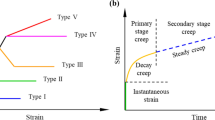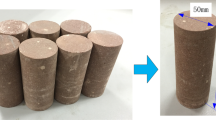Abstract
A phenomenological model has been developed for soft rock based on the results of a series of triaxial compression (TC) tests conducted on Kobe sandstone with a very high precision measurement. From the analysis and interpretation of the test results, it has been found that small strain Young’s modulus (Ee) was a function of the major principal stress. Ee for elastic strains of soft rock was assumed to be cross-anisotropic. A damage function has been used to derive the appropriate elastic Young’s modulus when subjected to shear loading. As the basic stress–strain relation, the relationship between the tangent modulus and the shear stress level was used. The differential form of which was subsequently integrated by a 4th order Runge–Kutta solver to obtain the stress–strain relation. The model of soft rock is based on an isotropic strain hardening elasto-plastic framework which takes into account the pressure sensitivity, cross-anisotropy, degradation of Young’s modulus with the degree of mobilized shear stress and the nonlinearity of the shear stress-shear strain relationship. Although the model was developed from the analysis of the TC tests results of Kobe sandstone, it was also applied to the other types of soft rock or stiff geomaterials. Plate loading tests were conducted at a level of 61 m below the ground level at the bottom of a large excavated shaft at four locations. Finally, the model was used to simulate the plate loading test results successfully. This model was successfully calibrated with Akashi sandstone and applied in the simulation for the settlement of Akashi-Kaikyo Bridge piers. The simulations were carried out for both drained and undrained condition by changing the Poisson’s ratio. The layering information beneath the foundations were used in the FEM simulation. The use of very accurate Young’s modulus from the field shear wave velocity test was the key to the successful simulation of the settlement under bridge pier foundations.





























Similar content being viewed by others
References
Adachi T, Ogawa T (1980) Mechanical properties and failure criterion of soft sedimentary rock. J Geotech Eng, JSCE 295:51–63 (in Japanese)
Aki K, Adachi T, Nishi K (1978) Elasto-Plastic behaviours of soft sedimentary rock (Porus tuff). J Geotech Eng, JSCE 271:75–96 (in Japanese)
Aki K, Adachi T, Nishi K (1979) Time dependent characteristics and constitutive equations of soft rock (porus tuff). J Geotech Eng, JSCE 282:75–96 (in Japanese)
Flanagan DP, Belytschko T (1981) A uniform strain hexahedron and quadrilateral with orthogonal hourglass control. Int J Num Methods Eng 17:679–706
Goto S, Burland JB, Tatsuoka F (1999) Non-linear soil model with various strain levels and its application to axisymmetric excavation problem. Soils Found 39(4):111–119
Hattori K, Muranaka K, Nishie (1995) Failure criterion and Mohr’s envelope for sedimentary soft rocks considering tensile strength. Rock Foundation, Yoshinaka & Kikuchi (eds), Balkema, Rotterdam
Hayano K, Sato T, Tatsuoka F (1997) Deformation characteristics of a sedimentary softrock from triaxial compression tests using rectangular prism specimens. Geotechnique 47(3):439–449
Hobbs DW (1966) A study of behaviour of broken rock under triaxial compression and its application to Mine Roadways. Int J Rock Nech Mining Sci 3:11–14
Hoek E, Brown ET (1980) Underground excavations in rock. Institution of Mining and Metallurgy, London
Hoque E, Tatsuoka F (1998) Anisotropy in the elastic deformation of materials. Soils Found 38(1):163–179
Hoque E, Tatsuoka F, Sato T (1996) Measuring aniso-tropic elastic properties of sand using a large triaxial specimen. Geotech Test J, ASTM 19(4):411–420
Jiang GL, Kohata Y (1998) Deformation properties of a well-graded crushed gravel subjected to cyclic triaxial loading. J Railw Tech Res Ins 12(4):43–48 (in Japanese)
Jiang GL, Kohata Y, Sunaga M (1998) Some factors affecting deformation characteristics at small strains of a sandy gravel. J Railw Tech Res Ins 12(4):49–54 (in Japanese)
Kashima S, Yamamoto S, Takahashi M Sasao, Yamada S, (1995) Large scale sampling of Akashi gravelly layer and its mechanical property. Rock Foundation, Yoshinaka & Kikuchi (eds), Balkema, Rotterdam
Kohata Y, Tatsuoka F, Dong J, Teachavorasinskun S, Mizumoto K (1994) Stress states affecting elastic deformation moduli of geomaterials. Proc. of Int. Sympo. on Prefailure Deformation Characteristics of Geomaterials, IS-Hokkaido,’94, Balkema, 1, 3–9
Kohata Y, Tatsuoka F, Wang L, Jiang GL, Hoque E, Kodaka T (1997) Modelling the non-linear deformation properties of stiff geomaterials. Geotechnique 47(3):563–580
Ortiz M, Simo JC (1986) An analysis of a new class of integration algorithms for elasto-plastic constitutive relations. Int J Num Methods Eng 23:353–366
Park CS, Tatsuoka F (1994) Anisotropic strength and deformation of sands in plane strain compression. Proc. XIII ISCMFE, New Delhi, India, Vol. I: 1–4
Siddiquee MSA (1994) FEM Simulation of deformation and failure of stiff geomaterials based on element test results, Ph.D. Thesis, The University of Tokyo, Japan
Siddiquee MSA, Tatsuoka F, Hoque E, Tsubouchi T, Yoshida O, Yamamoto S, Tanaka T (1994) FEM simulation of footing settlement for stiff geomaterials, Proc. of Int. Symposium Pre-Failure Deformation of Geomaterials (Shibuya et al., eds.), Balkema 1: 531–537
Siddiquee MSA, Tatsuoka F, Kohata Y, Yoshida O, Yamamoto Y, Tanaka T (1995) Settlement of a Pier Foundation for Akashi-Kaikyo Bridge and its numerical analysis, Proc. Int. Workshop on Rock Foundation of Large Scale Structures, Tokyo, Balkema 413–420
Tanaka T, Kawamoto O (1988) Three dimensional finite element collapse analysis for foundations and slopes using dynamic relaxation,” Proc. of Num. methods in geomechanics, Istanbul 1213–1218
Tatsuoka F, KimYS (1995) Deformation of shear zone in sedimentary soft rock observed in triaxial compression, Localisation and Bifurcation Theory for Soils and Rocks (Chambon et al. eds), Balkema 181–187
Tatsuoka F, KohataY (1995) Stiffness of hard soils and soft rocks in engineering applications, Keynote Lecture, Proc. of Int. Symposium Pre-Failure Deformation of Geo-materials (Shibuya et al. eds), Balkema 2:947–1063
Tatsuoka F, Lo Presti DCF, Kohata Y (1995) Deformation characteristics of soils and soft rocks under monotonic and cyclic loads and their relationships. SOA Report, Proc. of the Third Int. Conf. on Recent Advances in Geotechnical Earthquake Engineering and Soil Dynamics. St Luis (Prakash eds.), 2: 851–879
Yoshinaka R, Yamabe T (1980) Strength criterion of rocks. Soils and Foundation, JSSMFE 20(4):113–126
Author information
Authors and Affiliations
Corresponding author
Rights and permissions
About this article
Cite this article
Siddiquee, M.S.A., Islam, M.S. & Tatsuoka, F. Development of a Nonlinear Model for Soft Rock and its Applications. Geotech Geol Eng 31, 627–645 (2013). https://doi.org/10.1007/s10706-013-9613-y
Received:
Accepted:
Published:
Issue Date:
DOI: https://doi.org/10.1007/s10706-013-9613-y




